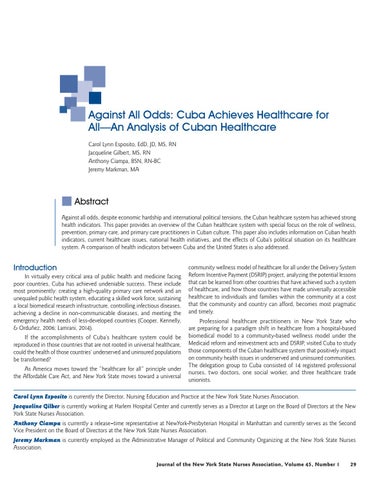Against All Odds: Cuba Achieves Healthcare for All—An Analysis of Cuban Healthcare Carol Lynn Esposito, EdD, JD, MS, RN Jacqueline Gilbert, MS, RN Anthony Ciampa, BSN, RN-BC Jeremy Markman, MA
■ Abstract Against all odds, despite economic hardship and international political tensions, the Cuban healthcare system has achieved strong health indicators. This paper provides an overview of the Cuban healthcare system with special focus on the role of wellness, prevention, primary care, and primary care practitioners in Cuban culture. This paper also includes information on Cuban health indicators, current healthcare issues, national health initiatives, and the effects of Cuba’s political situation on its healthcare system. A comparison of health indicators between Cuba and the United States is also addressed.
Introduction In virtually every critical area of public health and medicine facing poor countries, Cuba has achieved undeniable success. These include most prominently: creating a high-quality primary care network and an unequaled public health system, educating a skilled work force, sustaining a local biomedical research infrastructure, controlling infectious diseases, achieving a decline in non-communicable diseases, and meeting the emergency health needs of less-developed countries (Cooper, Kennelly, & Orduñez, 2006; Lamrani, 2014). If the accomplishments of Cuba’s healthcare system could be reproduced in those countries that are not rooted in universal healthcare, could the health of those countries’ underserved and uninsured populations be transformed? As America moves toward the “healthcare for all” principle under the Affordable Care Act, and New York State moves toward a universal
community wellness model of healthcare for all under the Delivery System Reform Incentive Payment (DSRIP) project, analyzing the potential lessons that can be learned from other countries that have achieved such a system of healthcare, and how those countries have made universally accessible healthcare to individuals and families within the community at a cost that the community and country can afford, becomes most pragmatic and timely. Professional healthcare practitioners in New York State who are preparing for a paradigm shift in healthcare from a hospital-based biomedical model to a community-based wellness model under the Medicaid reform and reinvestment acts and DSRIP, visited Cuba to study those components of the Cuban healthcare system that positively impact on community health issues in underserved and uninsured communities. The delegation group to Cuba consisted of 14 registered professional nurses, two doctors, one social worker, and three healthcare trade unionists.
Carol Lynn Esposito is currently the Director, Nursing Education and Practice at the New York State Nurses Association. Jacqueline Gilber is currently working at Harlem Hospital Center and currently serves as a Director at Large on the Board of Directors at the New York State Nurses Association. Anthony Ciampa is currently a release–time representative at NewYork-Presbyterian Hospital in Manhattan and currently serves as the Second Vice President on the Board of Directors at the New York State Nurses Association. Jeremy Markman is currently employed as the Administrative Manager of Political and Community Organizing at the New York State Nurses Association. Journal of the New York State Nurses Association, Volume 45, Number 1
29



